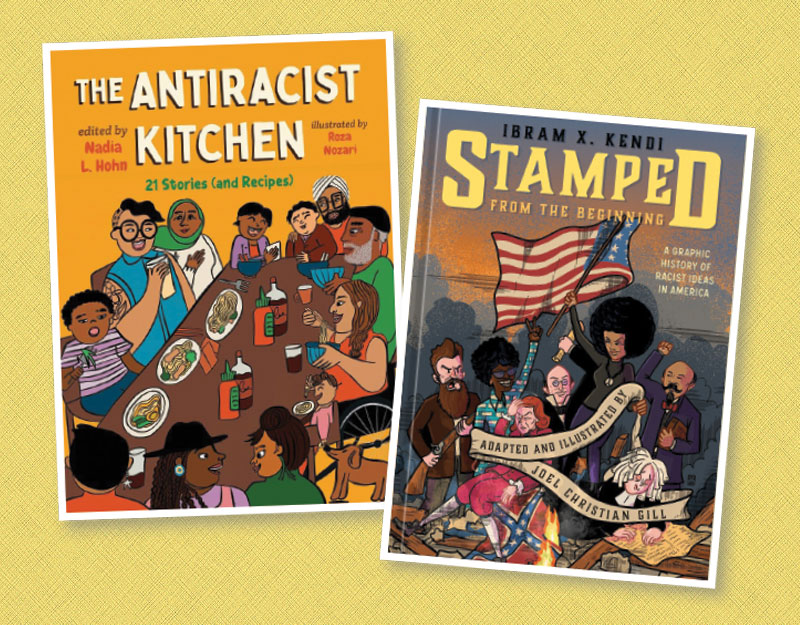2 Titles That Make Antiracism Accessible for Young Readers | Nonfiction Spotlight
The weighty subject of antiracism—actively dismantling the systems of oppression that are based on race—is made more approachable through these titles.

It’s never too early for kids to learn about antiracism. The weighty subject—actively dismantling the systems of oppression that are based on race—is made more approachable through this cookbook and graphic novel for young people.
 Hohn, Nadia L., ed. The Antiracist Kitchen: 21 Stories (and Recipes). illus. by Roza Nozari. 160p. Orca. Sept. 2023. Tr $29.95. ISBN 9781459833432.
Hohn, Nadia L., ed. The Antiracist Kitchen: 21 Stories (and Recipes). illus. by Roza Nozari. 160p. Orca. Sept. 2023. Tr $29.95. ISBN 9781459833432.
Gr 4 Up–A celebration of diversity in the form of a cookbook. This title includes 21 stories from many bestselling authors about growing up, family, cultural traditions, and bringing people together over food. Many of the stories include situations and microaggressions people of color have experienced throughout their lives. While some of the stories are sad, they end on a happy note and a delicious recipe follows. The book is broken down into four chapters based on the types of stories included: reclamation, resistance, restoration, and rejoicing. Some words and ideas may be difficult for younger readers to grasp, but with the help of an adult, and the glossary at the end of the book, they will likely understand. Attractive, cartoon illustrations accompany each tale to help readers understand events in the text. Pictures of the completed recipes are included. Aspiring kid chefs will enjoy trying out these original recipes. VERDICT The author asks, “What if talking about racism was as easy as baking a cake?” With this book, it could be. Recommended for all libraries.–Lisa Buffi
Kendi, Ibram X. Stamped from the Beginning: A Graphic History of Racist Ideas in America. adapt. by Joel Christian Gill. illus. by Joel Christian Gill. 288p. Ten Speed. Jun. 2023. Tr $29.99. ISBN 9781984859433.
Gr 9 Up–Kendi’s antiracism opus receives a pointedly visual adaptation from Gill (Fights: One Boy’s Triumph Over Violence). Since the beginning of America, there have been racist, assimilationist, and antiracist ideas, and people who spoke for or against them. The evolution of these ideas is seen through the lens of five historical figures: Cotton Mather, Thomas Jefferson, William Lloyd Garrison, W.E.B. DuBois, and Angela Davis. As guides, the five demonstrate how the country takes a step forward with emancipation and civil rights, but several steps back with Jim Crow laws and the War on Drugs. Gill uses gray scale and cartoonish illustrations that place emphasis on the subject, lively gestures, and facial expressions. For every 20 panels or so of serious commentary, there are scenes of historical figures with heart-shaped eyes because someone agreed with them, or a page presenting assimilationists as wannabe superheroes. Gill also blends historical quotes and statements from the original edition with modern colloquialisms. The latter brings a lightness to the subject, making the book accessible outside of academia. Notably, Gill encases racists and assimilationist comments in black speech bubbles that drip like sticky ooze. VERDICT A welcome, educational addition to social justice collections.–Maryjean Riou
RELATED
Tide’s Journey
Whose Footprint Is That?
The Tiniest Giant
The job outlook in 2030: Librarians will be in demand
The job outlook in 2030: Librarians will be in demand
ALREADY A SUBSCRIBER? LOG IN
We are currently offering this content for free. Sign up now to activate your personal profile, where you can save articles for future viewing






Add Comment :-
Be the first reader to comment.
Comment Policy:
Comment should not be empty !!!